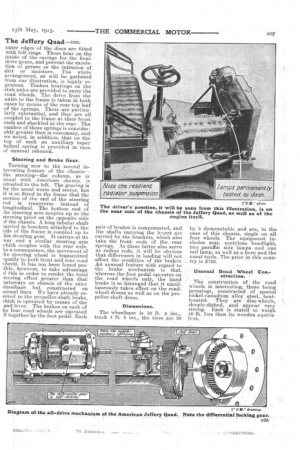The Jeffery Quad—con.
Page 5

If you've noticed an error in this article please click here to report it so we can fix it.
outer edges of the discs are fitted with felt rings. These bear on the inside of the casings for the finaldrive gears, and prevent the exudation of grease or the intrusion of dirt or moisture. The whole arrangement, as will be gathered from our illustration, is highly ingenious. Timken bearings on the stub axles are provided to carry the road wheels. The drive from the axles to the frame is taken in both cases by means of the rear top leaf of the springs. These are particularly_ substantial, and they are all coupled to the frame at their front ends and shackled at the rear. The camber of these springs is considerably greater than is customary, and we noted, in addition, that on the top of each an auxiliary taper helical spring is provided in case of unusual rebound.
Steering and Brake Gear.
Turning now to the second interesting feature of the chassis— the steering—the column, as is usual with American chassis, is situated to the left. The gearing is by the usual worm and sector, but it is so fitted in the frame that the motion of the end of the steering rod is transverse instead of Longitudinal. The bottom end of he steering arm couples up to the steering pivot on the opposite side A the chassis. A long tubular shaft 3arried in brackets attached to the 3ide of the frame is coupled up to ;his steering gear. It carries at its 'ear end a similar steering arm which couples with the rear axle. ks a consequence, the movement of he steering wheel is 'transmitted lqually to both front and rear road vheels. It has not been found poslible, however, to take advantage 3f this in order to render the total teering effect greater than that ustomary on chassis of the same vheelbase but constructed on iormal lines. We have already reerred to the propeller-shaft brake, ihich is operated by means of the and lever. The brakes on each of he four road wheels are operated .11 together by the foot pedal_ Each pair of brakes is compensated, and the shafts carrying the levers arc carried by the brackets, which also take the front ends of the rear springs. As these latter also serve as radius rods, it will be obvious that differences in loading will not affect the condition of the brakes. An unusual feature with regard to the brake mechanism is that, whereas the foot pedal operates' on the road wheels only, the hand brake is so 'arranged that it simultaneously takes effect on the roadwheel drums as well as on the propeller-shaft drum.
Dimensions.
The wheelbase is 10 ft. 4 ins., track 4 ft. 8 ins., the tires are 38 by 5 demountable and are, in the case of this chassis, single on all four wheels. The equipment includes seat, acetylene headlight, two paraffin side lamps and one tail lamp, as well as a horn and the usual tools. The price in this coml.. try is £750.
Unusual Road Wheel Construction.
The construction of the road wheels is interesting; these being pressings, constructed of special nickel-vanadium alloy steel, heattreated. They are disc-wheels, deeply-dished, and appear" very strong. Each is stated to weigh 40 lb less than its wooden equivalent.






















